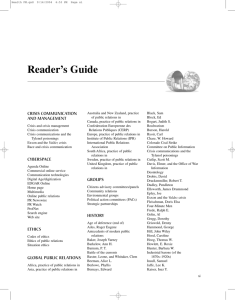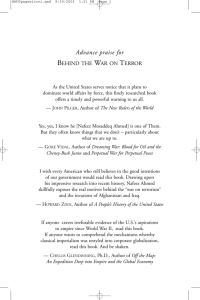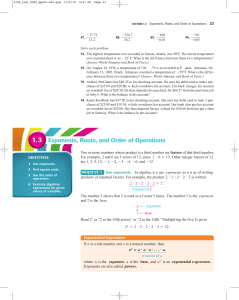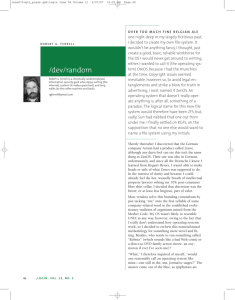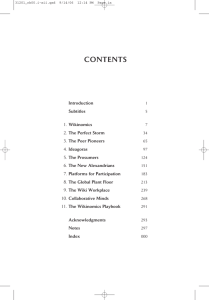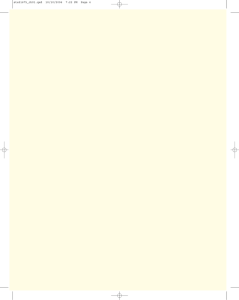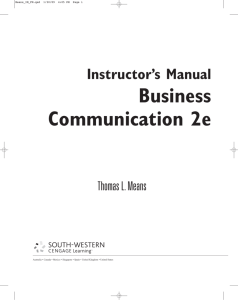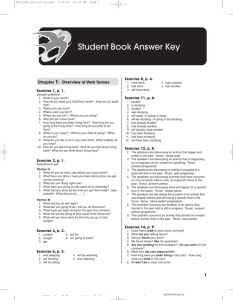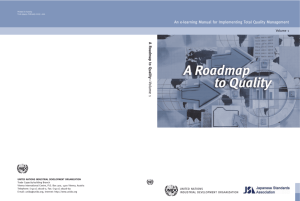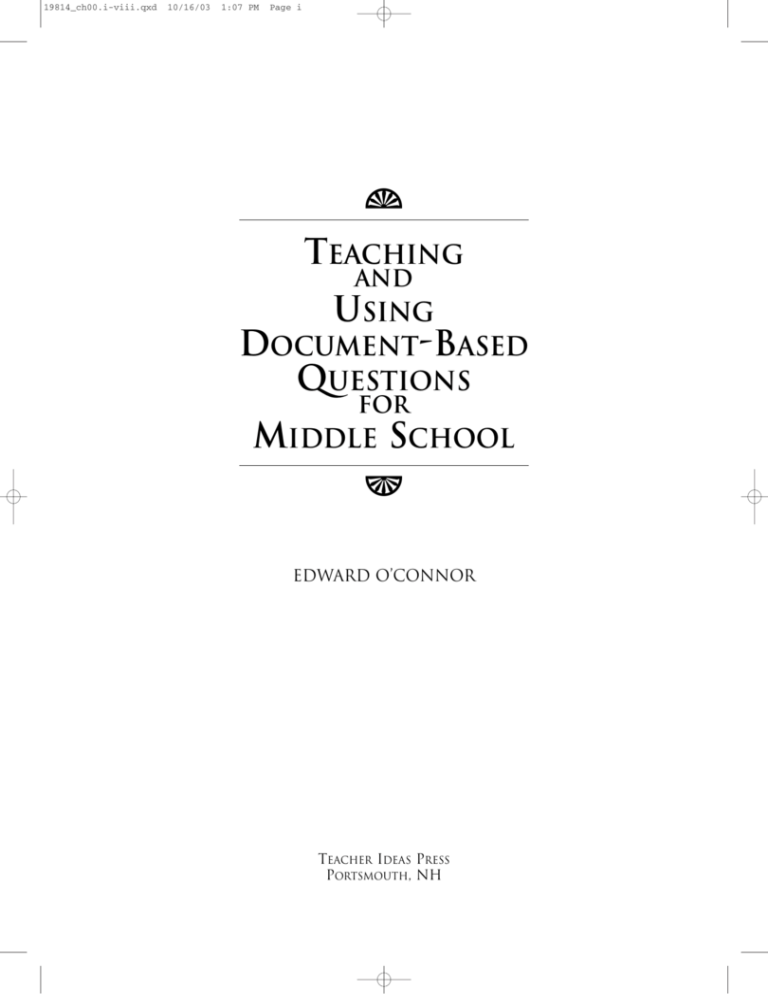
19814_ch00.i-viii.qxd
10/16/03
1:07 PM
Page i
J
TEACHING
AND
USING
DOCUMENT-BASED
QUESTIONS
for
MIDDLE SCHOOL
j
EDWARD O’CONNOR
TEACHER IDEAS PRESS
PORTSMOUTH, NH
19814_ch00.i-viii.qxd
10/16/03
1:07 PM
Page ii
TO PATTY—WITH
ALL MY LOVE.
Teacher Ideas Press
A division of Reed Elsevier Inc.
361 Hanover Street
Portsmouth, NH 0380-3912
www.teacherideaspress.com
Offices and agents throughout the world
© 2004 by Edward O’Connor
All rights reserved. No part of this book may be reproduced in any form or by any
electronic or mechanical means, including information storage and retrieval systems,
without permission in writing from the publisher, except by a reviewer, who may quote
brief passages in a review. Reproducible pages may be copied for classroom and
educational programs with the exception of the excerpt, “I, Too, Sing America,”
from The Collected Poems of Langston Hughes by Langston Hughes, located on page 110.
The author and publisher wish to thank those who have generously given permission to reprint borrowed material.
A list of permissions can be found on page 194.
Library of Congress Cataloging-in Publication Data
O'Connor, Edward P.
Teaching and using document-based questions for middle school / Edward P. O'Connor.
p. cm.
ISBN 1-56308-974-2
1. United States—History—Study and teaching (Middle school) 2. United States—History—Sources. I. Title.
E175.8 .O27 2003
973'.071'2—dc22
2003014229
Editor: Suzanne Barchers
Production Coordinator: Angela Laughlin
Typesetter: Westchester Book Services
Cover design: Joni Doherty
Manufacturing: Steve Bernier
Printed in the United States of America on acid-free paper
08
07
06
05
04
VP
1
2
3
4
5
19814_ch00.i-viii.qxd
10/16/03
1:07 PM
Page iii
J
CONTENTS
ACKNOWLEDGMENTS . . . . . . . . . . . . . . . . . . . . . . . . . . . . . . . . . .
V
INTRODUCTION . . . . . . . . . . . . . . . . . . . . . . . . . . . . . . . . . . . .
VII
1. Native American Cultures . . . . . . . . . . . . . . . . . . . . . . . . . . . . . .
1
2. The Age of Exploration . . . . . . . . . . . . . . . . . . . . . . . . . . . . . . . .
9
3. Democracy in Colonial America . . . . . . . . . . . . . . . . . . . . . . . . .
19
4. Loyalists and Patriots in the Revolution . . . . . . . . . . . . . . . . . . . .
27
5. Political Parties and the New Nation . . . . . . . . . . . . . . . . . . . . . .
37
6. Differences Between the North and the South . . . . . . . . . . . . . . .
47
7. Slavery in the United States . . . . . . . . . . . . . . . . . . . . . . . . . . . . .
58
8. Reconstruction . . . . . . . . . . . . . . . . . . . . . . . . . . . . . . . . . . . . . . .
69
9. Immigration . . . . . . . . . . . . . . . . . . . . . . . . . . . . . . . . . . . . . . . . .
79
10. The Growth of Industry . . . . . . . . . . . . . . . . . . . . . . . . . . . . . . . .
90
11. The Progressive Era . . . . . . . . . . . . . . . . . . . . . . . . . . . . . . . . . . .
99
12. America in the 1920s . . . . . . . . . . . . . . . . . . . . . . . . . . . . . . . . . . 108
13. The Great Depression and the New Deal . . . . . . . . . . . . . . . . . . . 119
14. America in World War II . . . . . . . . . . . . . . . . . . . . . . . . . . . . . . . 129
15. America and the Cold War . . . . . . . . . . . . . . . . . . . . . . . . . . . . . . 140
16. The Civil Rights Movement . . . . . . . . . . . . . . . . . . . . . . . . . . . . . 151
APPENDIX I: RUBRIC
FOR
SCAFFOLDING QUESTIONS . . . . . . . . 161
APPENDIX II: INTERNET RESOURCES . . . . . . . . . . . . . . . . . . . . . 181
SOURCES
FOR
WORKS CITED . . . . . . . . . . . . . . . . . . . . . . . . . . 185
COPYRIGHT ACKNOWLEDGMENTS . . . . . . . . . . . . . . . . . . . . . . 194
INDEX . . . . . . . . . . . . . . . . . . . . . . . . . . . . . . . . . . . . . . . . . . . 195
ABOUT
THE
AUTHOR . . . . . . . . . . . . . . . . . . . . . . . . . . . . . . . . 197
19814_ch01.qxd
10/16/03
1:18 PM
Page 1
1
J
DBQ THEME:
NATIVE AMERICAN CULTURES
DIRECTIONS:
This task is based on the accompanying documents (1–6). Some of these documents have been edited
to help you with the task. The essay is designed to test your ability to work with historical documents
and your knowledge of Native American cultures. Carefully analyze the documents as you complete
Part A. Your responses should help you to write the essay in Part B.
HISTORICAL CONTEXT:
For thousands of years, Native American tribes developed and flourished throughout North and South
America. These cultures developed very differently from one another, largely due to the various climates
and lands to which they had to adapt. To survive in sometimes harsh environments, Native Americans
had to put a great deal of time and energy into making the most of the natural resources that were available to them.
TASK:
• Describe at least three natural environments Native Americans adapted
to in North America.
• Discuss specific steps Native Americans took to survive in these
environments.
19814_ch01.qxd
10/16/03
1:18 PM
Page 2
PART A—SHORT-ANSWER SECTION
The following documents relate to Native American cultures. Examine each document carefully and
answer the questions that follow it.
Document 1: Native American Culture Chart
1. Name two Native American groups that did not develop agriculture.
(2)
2. Give two examples of how the Inuit were affected by living in an arctic climate.
(2)
May be copied for classroom use. Teaching and Using Document-Based Questions for Middle School by Edward O’Connor
(Portsmouth, NH: Teacher Ideas Press); ©2004.
2
19814_ch01.qxd
10/16/03
1:18 PM
Page 3
NATIVE AMERICAN CULTURES
Document 2: Hohokum Irrigation Canals
Courtesy Arizona State Museum, University of Arizona
This is a photo of canals built by the Hohokum and unearthed by archaeologists at Snaketown, Arizona. The Hohokum constructed hundreds of miles of canals throughout the dry lands of the southwest.
1. What are two things for which the Hohokum used these canals?
(2)
2. Why would the Hohokum need to build canals like this to survive?
(1)
3
19814_ch01.qxd
10/16/03
1:18 PM
Page 4
TEACHING
AND
USING DOCUMENT-BASED QUESTIONS
FOR
MIDDLE SCHOOL
Document 3: Making Canoes in Virginia (1722)
When in their travels, if the Indians meet with any waters that cannot be
crossed, they make canoes of birch bark, by slipping it whole off the tree, in
this manner. First, they gash the bark quite round the tree, at the length they
would want the canoe to be, then slit down the length from end to end; when
that is done, they with their tomahawks easily open up the bark, and strip it
whole off. Then they force it open with sticks in the middle, slope the underside with the ends, and sow them up, which helps keep the belly open; or if
the birch trees happen to be small, they sow the bark of two together. The
seams they coat with clay or mud, and then pass over the water in their
canoes, by two, three or more at a time, according to their size. By reason of
the lightness of these boats, they can easily carry them over land, if they foresee that they are likely to meet with any more waters that may get in their
way . . .
1. What is the advantage of making canoes that are light?
(1)
2. Name at least two materials found in nature used to make a canoe.
(2)
4
19814_ch01.qxd
10/16/03
1:18 PM
Page 5
NATIVE AMERICAN CULTURES
Document 4: Description of a Native American Home (Kansas 1869)
. . . it seemed as though the level plain was dotted with huge hay stacks . . .
but how symmetrical and beautiful: thirty to forty feet high, and as though
they were laid out by the rules of geometry! As we near them we soon discover that our hay stacks are the houses of the Witchitas, built of straw,
thatched layer upon layer, with stout bindings of willow-saplings, tied
together with buffalo hide or stripped hickory. They invite you in with much
politeness, and, accepting their hospitality, you find yourself in a clean and
comfortable dwelling.
In the center is the fire. Around the sides the beds are fitted up on bunks
raised three feet from the floor, built of split-boards, tied together with cords
made of buffalo hide. The floor is hard packed earth, clean as can be. The
builders have wisely made the best of their resources. The grass, willowsaplings, buffalo hide etc. . . . are all found close at hand; and out of these,
which would not have been any use to us in house-building, the Witchitas
have built the most convenient homes.
1. What are two ways that the Witchitas used buffalo hide, according to this passage?
(2)
2. According to the author, how have the Witchitas made good use of their natural resources?
(2)
5
19814_ch01.qxd
10/16/03
1:18 PM
Page 6
TEACHING
AND
USING DOCUMENT-BASED QUESTIONS
FOR
MIDDLE SCHOOL
Document 5: Photograph of Cheyenne Tipis and Travois
Courtesy Denver Public Library
Many Plains tribes would join two poles with a frame to create a travois, like the one shown above.
Pulled by a horse, the travois enabled people to move their tipis and other belongings easily as they
pursued buffalo herds.
1. For what did Native Americans on the Great Plains use the travois?
(1)
2. Why would hunters like the Cheyenne shown here need to be able to move their belongings?
(1)
6
19814_ch01.qxd
10/16/03
1:18 PM
Page 7
NATIVE AMERICAN CULTURES
Document 6: An Indian Boy’s Training
It seems to be a popular idea that all Indians are born with the skills and
instincts for which they are well known. This is a mistake. All the patience and
skills of the Indian are acquired traits, and continual practice alone makes
him the master of the art of wood-craft. My uncle, who educated me up to the
age of fifteen years, was a strict disciplinarian, and a good teacher. When I
left the tipi in the morning, he would say, “Hakadah, look closely at everything you see”; and at evening, on my return he would often instruct me for an
hour or so. . . . He meant to make me observant and a good student of nature.
“Hakadah,” he would say to me, “it is better to view animals unobserved.
I have been witness to many of their courtships and quarrels and have
learned many of their secrets in this way . . . I advise you, never to approach
a grizzly’s den from the front, but to steal up behind and throw your blanket
or a stone in front of the hole. He does not usually rush for it, but first puts his
head out and listens and then comes out very slowly . . . While he is exposing
himself in this fashion, aim at his heart. Always be as cool as the animal himself.” This is how he armed me against the cunning of the savage beasts, by
teaching me how to outwit them.
1. What are two things the author was taught by his uncle?
(2)
2. According to this passage, what are two traits that Indians must develop to be masters of woodcraft?
(2)
7
19814_ch01.qxd
10/16/03
1:18 PM
Page 8
NAME
DATE
PART B—ESSAY: NATIVE AMERICAN CULTURES
TASK:
Using the documents in your packet, your answers to the questions in Part A, and your knowledge of
social studies, write a well-developed essay that includes an introduction, supporting paragraphs, and a
conclusion in which you thoroughly address the following:
• Describe at least three natural environments that Native Americans
adapted to in North America.
• Discuss specific steps Native Americans took to survive in these environments.
NOTE: your essay will be evaluated using the form below.
Point Value
Effective use of documents—
uses at least 4 documents
15
Accuracy—
includes correct information
15
Depth and detail—
supports main ideas with facts
10
Knowledge of social studies—
uses information beyond supplied documents
10
Clarity/Organization—
clearly expresses and logically develops ideas
10
Language mechanics—
uses proper spelling, grammar, and style
10
Correct format—
includes introduction, supporting paragraphs, and conclusion
10
TOTAL
80
Points Earned
Comments:
Part A Score
Part B Score
8
TOTAL SCORE




